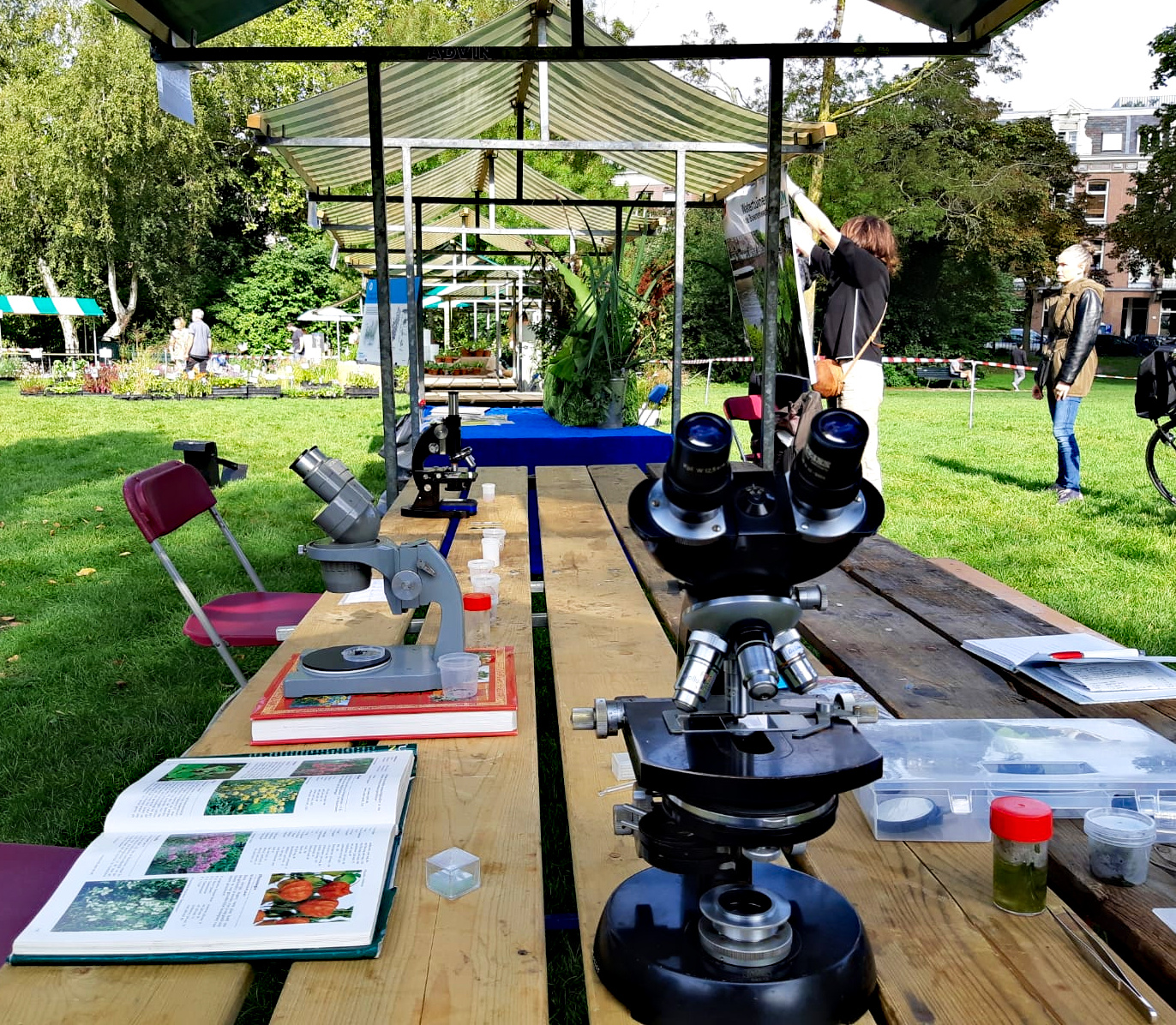
If you look through a microscope you will discover that a separate world exists that is usually hidden from us. Unlike binoculars, which are used to observe known things, you will enter an unknown world with a microscope. This world is a universe in itself. You will be amazed by the fantastic micro structures of plants and the bizarre shapes of single-celled organisms. Up close, leaves look like mosaic artworks and some single-celled creatures would do very well in a science-fiction film. Science and art are brought together with a microscope, it is actually quite strange that not many artists seem to have been inspired by the microscopic world. What's more, you will learn a lot about how nature works when you look through a microscope. Many people think that microscopy is too complicated or that a very expensive microscope is required. Nothing is less true. A lot can be seen with a simple school- or student microscope.
During the summer season I often stay at a garden park called Nieuw Vredelust in Duivendrecht. Here, I examine all kinds of things with a microscope. A garden park is a fantastic location for a microscopic adventure. There is so much to see and explore: during the summer the ditches are teeming with all kinds of microscopic life, colorful flowers and leaves are beautiful up close and you will be surprised by the look of small seeds when magnified.
Microscopy can also be very useful within the house. For example, if you're not sure if some food has been expired you would be able inspect it with a microscope and look for the presence of bacteria or fungi.
I would like to introduce people to the microscopic world. During the workshop you can look through different microscopes and examine things that you find interesting. After an introduction I will explain how to view the different samples with a microscope. This can be anything: plant cells, water from a ditch, pollen, hairs, sand, insects, small seeds, etc., etc. I will also explain what you are all seeing. Furthermore I will demonstrate how to take pictures through a microscope; with a smartphone you can already take very nice photos. There are several microscopes available and if you want to bring something with you to examine it yourself or to have it examined, you are very welcome.
Subjects workshop microscopy
Any people that have become interested after an introduction to microscopy, or those who want to learn more about certain subjects, can contact me for a more extensive workshop. Depending on the needs and interests of the participants the following topics could be covered:
Introduction
• Why microscopy as a hobby?
• The microscope, introduction, history, applications.
• Using the microscope, discussion of various parts.
• Types of microscopes.
Explanation about cells, tissues, structure of organisms
• Plants
• Animals
• Microorganisms
Working with a microscope
• From smallest to largest magnification
• Which magnification for which object?
• Dealing with exposure and aperture
• Focussing: coarse and fine adjustment
• Learn how to look with one eye while the other is kept open (monocular microscope)
• Working with a binocular microscope
Techniques
• Brightfield illumination / oblique illumination
• Darkfield illumination
• Phase contrast
• Using incident light
• Polarisation
Making slides from fresh material
• View raw materials: sand, seeds, leaves, etc.
• Simple preparations of pulp from: rose hip, potato, banana, tomato, sweet pepper
Ditch water
• View different types of algae
• Protozoa, diatoms, water fleas, rotifers
Cells from flowers
• Viola
• Tagetes
Examining leaves
• View intact leaves of Rosa, Fagus, Corylus, Tradescantia
• Make preparations of: Tradescantia zebrina, onion, Hosta, Prunus laurocerasus
Pollen
• Alcea rosea, sunflower, pine, tulip, lily
• Pollen in honey
Sand
• View different types of sand
Bacteria
• In buttermilk, yogurt, saliva
Cheek epithelial cells
• View cells from the inside of your mouth
Mosses
• Structure of miniature leaves
Aquatic plants and cytoplasmic streaming
• Movement of chloroplasts in Elodea
Insects
• Wings, scales butterfly wing
• Compound eye
• View insects with a stereo microscope
Hairs, fibers, dust
• View fibers and dust with polarized light
Blood
• View red and white blood cells, detect movement of white blood cells
Parasites in animals
• Investigation of pathogens in materials deriving from animals
Record your observations
• Drawing
• Photography
I sometimes do demonstrations on location, like shown here at the Sarphatipark in Amsterdam at the 'Herfstmarkt' of 2020. It was a beautiful sunny September day.
